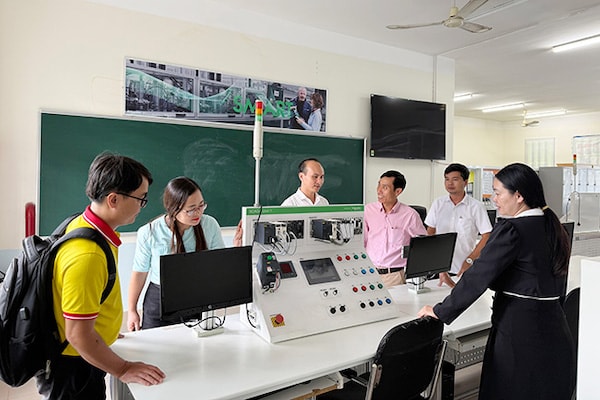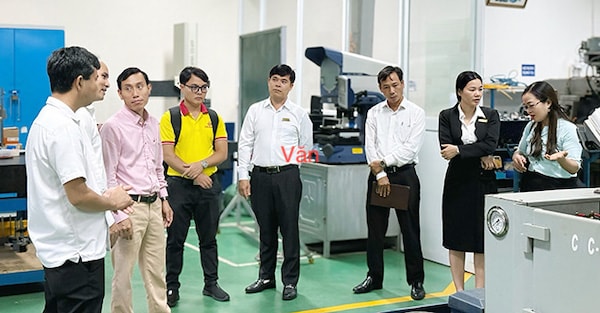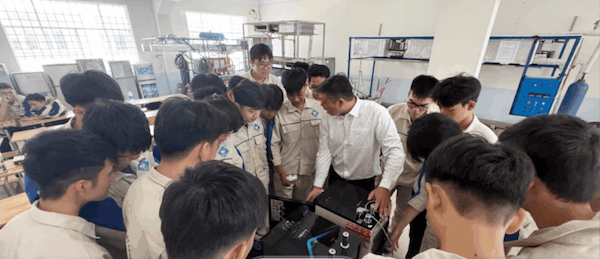Ho Chi Minh City (Ba Ria – Vung Tau area): Enhancing workforce quality
Ho Chi Minh City (Ba Ria – Vung Tau area) is striving to transform itself into a key economic hub of Vietnam. To achieve this goal, the quality of human resources is a decisive factor.

On July 9, 2025, Ba Ria – Vung Tau College of Engineering and Technology (BCTech) met with Dai Dung Group to foster cooperation in training and recruitment.
Feedback from businesses indicates that in recent years, Ho Chi Minh City (Ba Ria – Vung Tau area) has made significant progress in developing its vocational education and training (VET) system. The city fully recognizes the importance of developing a high-quality workforce to meet the rapidly changing demands of the labor market.
Strengthening School–Business Linkages
As of June 2025, there are 41 institutions engaged in VET activities in Ho Chi Minh City (Bà Rịa – Vũng Tàu area), offering training in over 30 core occupations that align with local economic development goals.
These institutions are distributed across multiple wards and communes, focusing on areas such as industrial engineering, information technology, tourism and services, logistics, and hi-tech agriculture. The city also supports technology innovation, digital transformation, and custom training programs tailored to business needs.
According to the Employment Service Center of Ho Chi Minh City (Bà Rịa – Vũng Tàu area), the region is expected to require about 15,000 workers in 2025, primarily in commerce and services, industry and construction, and agriculture–forestry–fishery. Nearly 100 mechanical projects and factories are currently operational in the area, offering ample employment opportunities for surplus labor.
Notably, the partnership between VET institutions and businesses has grown stronger and more substantive through the dual training model—where students study theory at school and practice directly at companies. This approach allows businesses to help design and update curricula, ensuring alignment with real-world technology and production processes.
Students benefit from hands-on experience in professional environments, enabling them to build practical skills and shorten the adaptation period after graduation, thereby increasing their competitiveness.
Many companies have committed to hiring students upon graduation if they meet performance and attitude requirements—addressing both the employment needs of learners and the talent pipeline for employers.
Moreover, some businesses proactively request specific workforce training from VET institutions, ensuring both quantity and quality are met.

On July 9, 2025, BCTech worked with Dai Dung Group to promote collaboration in workforce development.
Speaking with DĐDN, Mr. Phạm Văn Triêm, President of the Small and Medium Enterprise Association of Ho Chi Minh City (Bà Rịa – Vũng Tàu area), noted that most VET institutions maintain some form of cooperation with businesses—from internships and site visits to jointly developing curricula. This linkage is not only at the institutional level but also driven by industry associations and municipal initiatives.
The school-business partnership has delivered tangible results, especially in expanding real-world exposure for learners and meeting labor market demands. Through collaboration, VET institutions gain access to modern technology and equipment from businesses to improve practical training. Instructors also benefit from upskilling opportunities provided by company engineers and experts.
Students develop both soft skills (communication, teamwork, problem-solving) and hard skills (machine operation, production processes), boosting their confidence in job searches.
Short-term training and upskilling programs are tailored for current workers to improve productivity and income. In the context of Industry 4.0, retraining and continuous learning have become essential.
Such cooperation allows VET institutions to align with market demand, shifting from mass training to targeted skills development in fields facing labor shortages. This makes job placement easier for graduates and reduces skilled labor gaps for businesses.
In recent years, major companies in Ho Chi Minh City (Bà Rịa – Vũng Tàu area) have actively partnered with schools to recruit students early, particularly in sectors like petrochemicals, mechanics, electricity, electronics, logistics, and high-end tourism.
“Specifically, our Association also collaborates with the Center for Industrial Development Support under the Ministry of Industry and Trade to improve product quality and support industries through training for workers in SME businesses,” Mr. Triêm added.
Policy as a Lever
To improve workforce quality, Ho Chi Minh City (Bà Rịa – Vũng Tàu area) has implemented a series of synchronized and proactive policies.
For instance, the city offers incentives on land use, taxes, and credit to attract investment into VET, particularly in high-tech industries.
It strongly promotes public–private partnerships in vocational training, encouraging business involvement in the entire training cycle—from curriculum development to recruitment.
Students in key sectors or hard-to-recruit occupations with high market demand are supported through tuition subsidies and scholarships. Special attention is given to disadvantaged groups and ethnic minorities.
Regular training and professional development for VET teachers and lecturers are provided, covering subject expertise, pedagogy, and practical technological skills.
Teachers are encouraged to intern or work at enterprises to stay up-to-date with real-world knowledge. Incentives are also offered to attract industry experts to teach at VET institutions.
Local government funds are used to upgrade facilities and equipment in line with industry standards. The city also calls for international and private sector investment in training infrastructure.
Digital transformation in teaching and administration is being expanded, including virtual classrooms, e-libraries, and online learning platforms. Training is shifting from theory-based to competency-based models, emphasizing practical skills needed by employers.
More hands-on training and internships are being built into programs. Output standards are being standardized to ensure graduates are truly job-ready. Employers are invited to participate in final assessments.

Ho Chi Minh City (Bà Rịa – Vũng Tàu area) accelerates the shift from theory-based education to performance-based training, focusing on practical skills that meet employer needs.
The Department of Education and Training is working with other departments to forecast short- and long-term labor needs in the area, helping the city plan and prioritize training programs in key industries.
It also advises on incentive policies to attract domestic and international investment into VET, as well as scholarships, tuition support, and startup assistance for VET students.
Policies are in place to recruit, train, and retain high-quality VET staff and administrators. Mechanisms are also being developed to evaluate program quality and compliance.
The city leads efforts to strengthen school–business partnerships, revamp curricula, and apply modern training methods aligned with labor market and global trends. It is also working to change societal attitudes, shifting focus from degrees to practical skills, and providing early career guidance for high school students.
With continued effort, Ho Chi Minh City (Bà Rịa – Vũng Tàu area) is steadily working toward its goal of improving workforce quality. Still, challenges remain—such as the rapid pace of technological change, high demand for skilled workers, competition for talent from other regions, and lingering social bias favoring university degrees over vocational education.
To overcome these hurdles, the city must persist in implementing its strategic policies while remaining flexible to real-world developments. Investing in human capital remains the most sustainable path to long-term growth for both Ho Chi Minh City and the Bà Rịa – Vũng Tàu area.








